High quality headphones are quite possibly the most difficult things in the world to design. Not only do we have the all the factors that affect audio output - the frequency response, resonances, phase and distortion curves, acoustic pressurization, DSP, and so on - but we have the human-centric design as well - the colors, the textures, the materials, and of course “the feel”. All this engineering needs to then be shoehorned into a small, ear-sized package.
The way the headphones interact with our head and ears is a unique, and subjective, feeling for every individual. However, the engineer in all of us says “let’s quantify that!”. Which is exactly what we did with Aiwa, the iconic high quality audio brand that has recently been rebooted here in the U.S. The iconic Aiwa brand has been resurrected in the passionate pursuit of bringing people together around music. Aiwa has a simple formula for delivering serious audio equipment without compromise - with the best acoustic talent, the highest quality components and world-class customer service. How does it all come together? With cutting edge Research & Development.
THE APPROACH
To conduct comprehensive user experience testing would be a huge undertaking as the sample population would need to cover a near infinite variety of human attributes: widths, diameters, heights, and shapes related to our heads and ears. The Design of Experiments (DOE) for something like this would be both time consuming and very expensive. This is where simulation makes its business case. Instead of prototyping and testing a wide variety of products and people, why not use Finite Element Analysis (FEA) to simulate the interaction between the earpiece and the human head. If a working model that accurately captures the physics can be created, then we can easily apply that to a wide variety of earphone designs and human head geometry.
THE METHOD
First, representative geometry for both a human head and headphones was created in SOLIDWORKS. Again, our goal here was not to conduct a full Design of Experiment (which would require hundreds of human head shapes & sizes, as well as dozens of headphone designs), but rather to prove that a working model could be created. To do this, our focus was on accurately representing the physics at hand in FEA. This will give us the resultant forces, and thus pressures, that we feel on our head as we slide on a pair of high quality headphones. After some simple studies, we realized the motion required to install a set of headphones was quite complicated! The headphones are opened (“pre-stressed”), moved over the head, located around the ears, and then closed to their final position.

This seemed a bit overkill to simulate, so the motion was simplified (and symmetry was taken advantage of), with a simple model of a headphones which started out at rest, with the head being translated into its final position. By doing this, the simulation focused on the complex interaction between the head and the headphone, and not on the motion itself. Here's the final SOLIDWORKS model before transferring it to SIMULIA SSE (note the split line curve on around the ear that will be used for mesh control later).
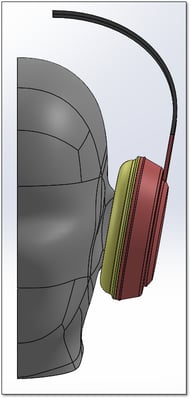
THE PHYSICS
The interaction between a pair of soft, comfortable pair of headphones and our fragile and sensitive ears is a very complex thing. To say that this mathematical model is “non-linear” is a gross understatement. Non-linearity in FEA can take many forms: Geometric, Material Properties, and sliding/frictional contact are three of the most common. Well, to start building any trust in our headphone working model, we would need to exercise all three:

Geometric Non-linearity - The Headphone frame is comprised of a long skinny frame which deflects quite a lot compared to its original size. Analyzing this type of geometry requires the use of "large deformations", which notifies SIMULIA SSE that the orientation between the geometry and the load will change due to large deformations, and to iteratively apply the load accordingly.
Contact Non-linearity - As the headphones come into contact with the head (or vice versa in our model), there is a lot of local, relative motion at the interface surfaces. This complex interaction can only be mathematically captured with a transient time stepping of the boundary conditions.
Material Non-linearity - The comfort we feel from headphones comes from the soft foam inside of the pads, as well as the elastomeric (rubber) covering that actually touches our ears. Both of these materials have very complex relationships between their stress and strain. In other words, their modulus of elasticity (the slope of the stress strain curve) changes quite a bit through the range of motion. Foam, in particular, has a modulus that can be divided into 3 sections. It is unrealistic to model the fine details of the open cell foam structure, but using the Hyperfoam model, it can be modeled quite easily using material testing data.
Due to this “triple threat” nonlinear requirements, we decided to use Dassault Systeme's new nonlinear FEA tool, called SIMULIA Structural Simulation Engineer (SSE), which combines the computing power and physics solver from Abaqus with the parametric CAD connection and usability from SOLIDWORKS. Pretty much the best of both worlds.
THE LEARNING CURVE
Coming from SOLIDWORKS Simulation we had a few new things to learn as we jumped into SIMULIA SSE. First, we needed to get the geometry over. This was quite easy as there is an add-on for SOLIDWORKS, so it was just a few clicks. Next, we familiarized ourselves with the GUI, which was quite easy given the layout conforms to the typical CAx layout with a model tree, graphics screen, and a feature dashboard along the bottom.
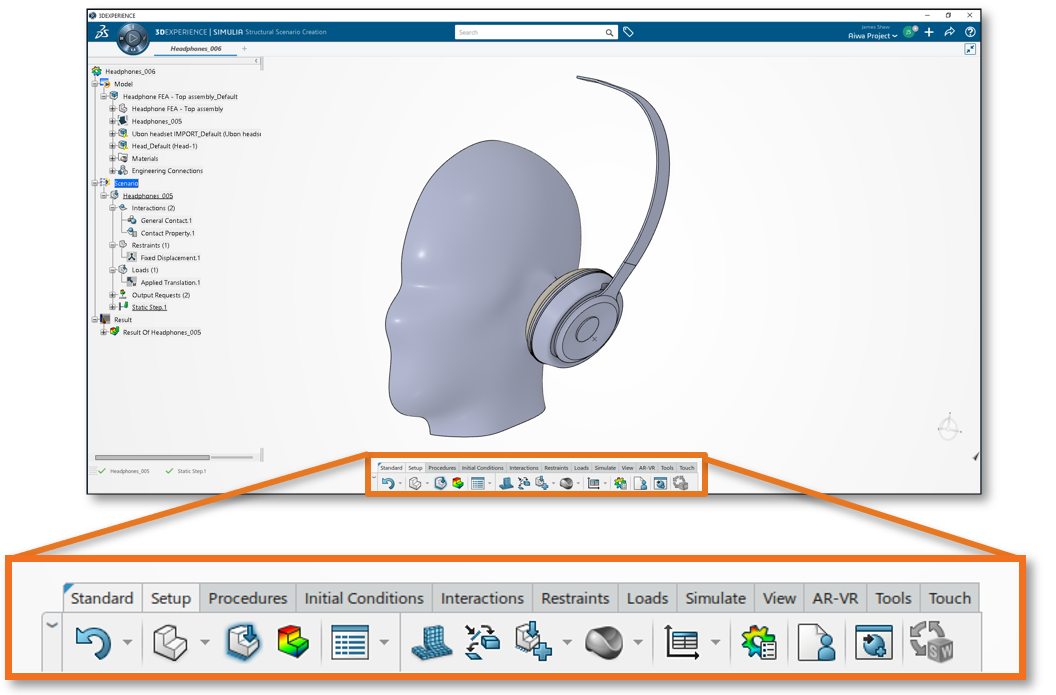
The workflow in SSE aligns with the standard FEA workflow, which can be broken down into 3 main steps: Pre-Processing, Solving, and Post-Processing. In this case, given the high level of non-linearity, our Pre-processing focused on three important areas: Material Definition, Mesh Control, and Contact Management.
Materials - For the nonlinear materials, we chose Hyperelastic Models to accurately capture the large amount of strain and the changing modulus. For the frame we used a simple ABS plastic, and for the foam we used the Hyperfoam material. Both are simple enough to be stable, but complex enough to more accurately capture the deflections.
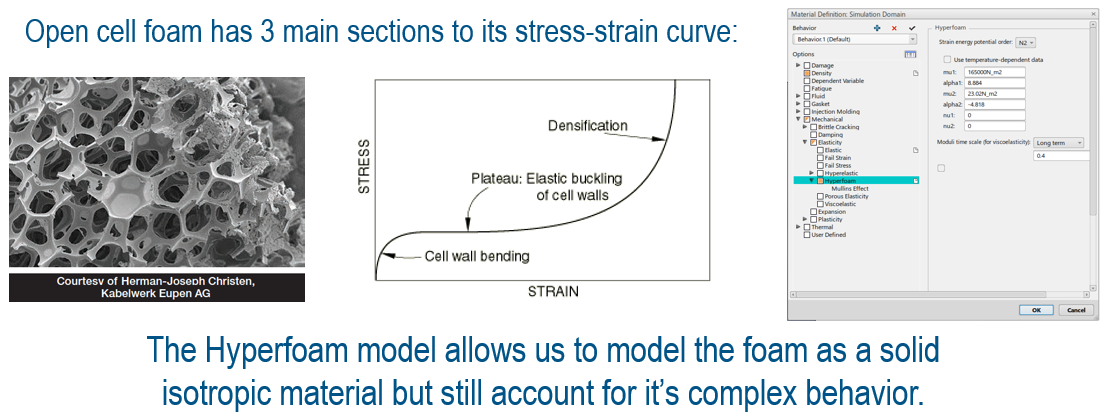
Meshing - For Meshing, we chose to use a Tetrahedral based mesh, as it can easily capture the complex surfaces of the human head as well as those on the soft materials of the headphones. Typically, however, for high deformation models (like hyperelastic materials) a hex mesh is ideal as the elements tend to deform in a more stable way. So, to account for this, we tightened up the mesh in the areas of contact and in the volumes of high deformation.
The workflow for meshing in SSE is a bit more complex than in SOLIDWORKS, but for good reason - there are a lot more tools, and with them a lot more control. For nonlinear analyses, this is mandatory, especially with hyperelastic models. The high deformation can cause elements to get deformed in very weird ways, and that could cause the analysis to diverge, or even crash. Troubleshooting is mandatory in complex FE analyses, but minimizing the amount of time we spend on it is still a goal. With a deep bench of mesh tools, we can really maximize the quality, and set up ourselves for success, mathematically.
To ensure that we had enough detail to capture the contact, we decreased the mesh size with several goals in mind: Create elements small enough to capture the geometry, create elements as close to equilateral as possible, and ensure the elements on either side of the contact are similar in size. The mesh shown here is approximately 500,000 elements (note the local mesh control around the ear, which references the split line in SOLIDWORKS as explained above).
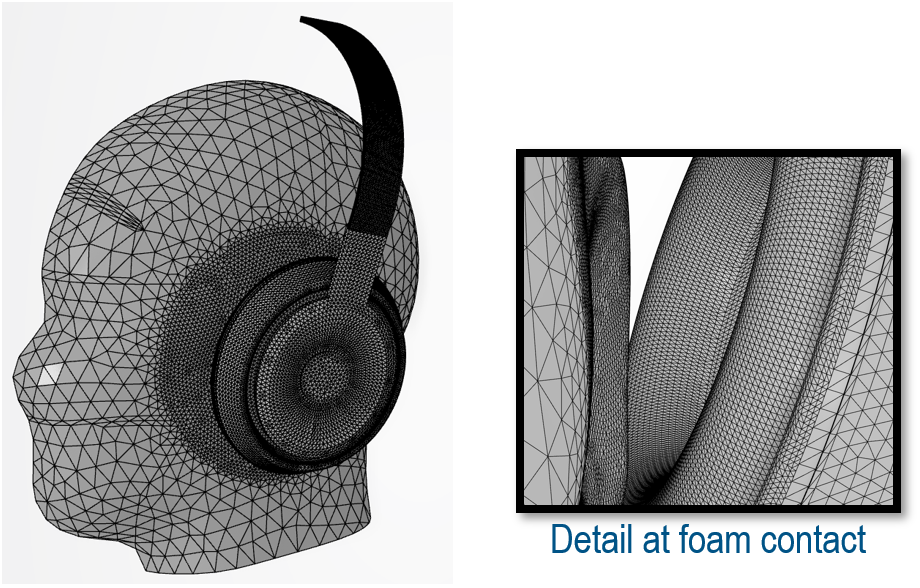
Using the Mesh Manager, and many of the other mesh assessment tools, we are able to quickly, and easily, review the elements and nodes for quantity and quality. Compared to SOLIDWORKS, SIMULIA SSE has much more capability when it comes to meshing as shown here for comparison:
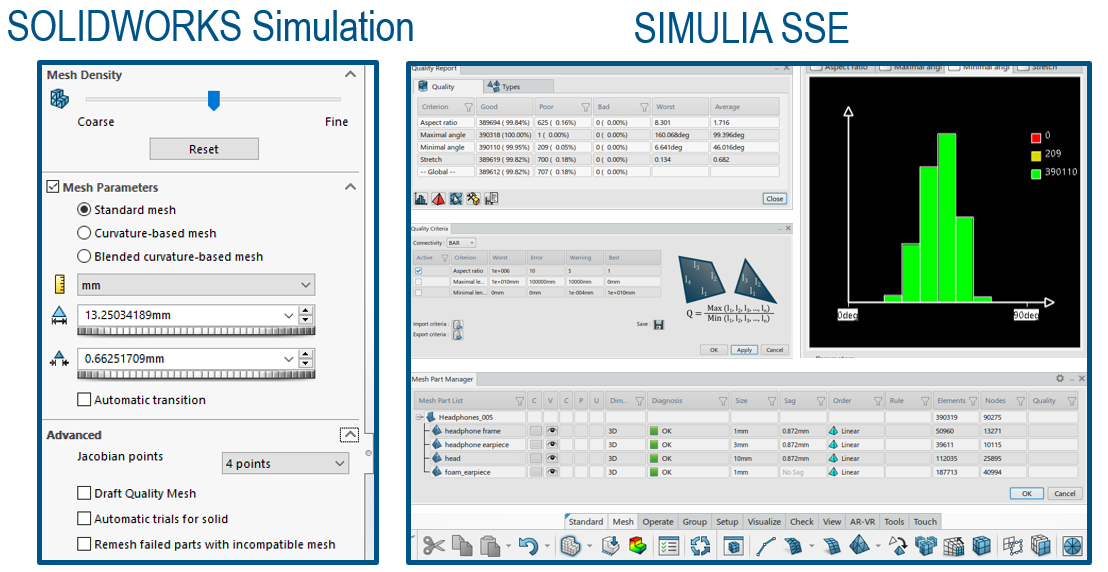
Contacts - Managing contacts in SSE is a bit different as well, and again it’s for similar reasons as the meshing - the user has greater control over the models (as shown in the comparison with SOLIDWORKS below). This does, however require a bit more training, so new users need to be prepared to do a bit more homework here. The good news is that the SSE team has created a handful of helpful pages, models, and tutorials, to help you up the learning curve. Trust us, this is time well spent, as a greater understanding results in less time spent troubleshooting and a greater overall confidence in your model.
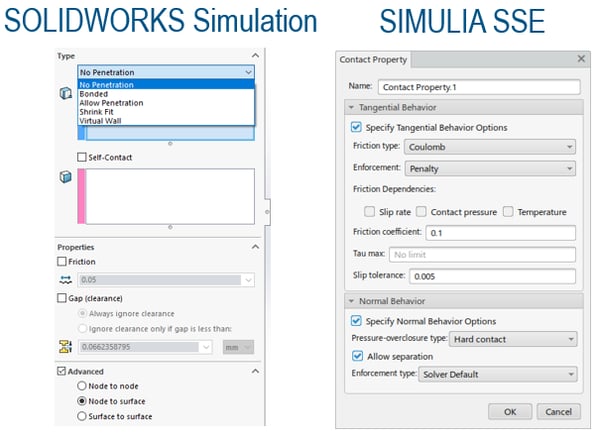
THE SOLVE
With the model set up, the human can take a rest and let the computer do its job. This is where SIMULIA SSE absolutely excels. It’s solver automatically sets up the time steps, which takes the pressure off of the end user. The time steps are critical in accurately capturing the complex interaction at the contacts. This is because SSE has to figure out which elements and nodes are touching, and accurately model the associating contact. When there is complex geometry involved, this can be quite challenging. SSE will recognize certain time steps which are challenging, and it will “slow down” the analysis, to allow for the contact to be carefully simulated. This is all done automatically. In addition, when solved in “interactive” mode, the end user can observe this process, and so if the time step starts to really slow down, the analysis can be stopped, and the results can be observed up to that point in time. This is critically important in troubleshooting, and can save many hours of waiting, checking, tweaking, and resolving.
THE RESULTS
The results of the analysis can be represented in both qualitative and quantitative terms. Qualitatively, we can review the stress (pressure) that is occurring on the surface of the head and around the ear. Of course, the assumption that our head is rigid is unrealistic, but it gives us an idea of what the pressure distribution would be in real life. For so-called over-ear headphones, the area of contact is the bony area surrounding the ear, so the user’s experience of pressure (and resulting discomfort) can be reasonably approximated with a rigid object. Below, we see the animations for displacement (left) and Von Mises Stress (right) viewed from the front.
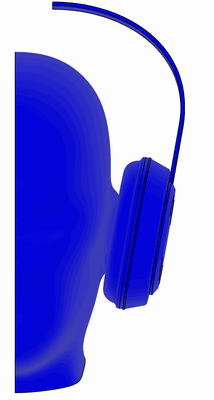

Quantitatively, we can extract out the a graph of the reaction force per time, and this could give us an idea of the “user experience” throughout the entire process of putting the headphones on. To correlate to actual test data would be challenging, but not impossible. Better material models would need to be obtained for the head and foam, but using placeholder materials to get a working model provides great insight into the time investment. Deciding to move forward is as much of a business decision as it is an engineering one!
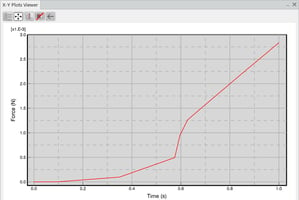

THE CONCLUSION
The main goal of this exercise was to create a working model where the physics could be accurately captured, and that goal was quite easily met as can be seen here. In this example, it took approximately 35 hours to build this model, including all of the CAD prep, contacts setup, divergence troubleshooting, and post processing. The next steps for this model are to refine it a bit with some more detail on the headphones side, and to research methods for modeling the material properties of the human head and ear. In addition, test plans should be created for how to correlate this model to actual real world activity. If the “loop” of engineering can be closed, than a full DOE can be build using SOLIDWORKS and SIMULIA SSE to investigate, and optimize a wide variety of design options and human geometry.
At Fastway Engineering, we help companies get the most out of Engineering Simulation tools, through expert services and in-classroom training. In addition to both Introductory and Advanced SOLIDWORKS FEA Training, we are currently in the process of building our SIMULIA SSE training, to get early access to it, contact us below!



